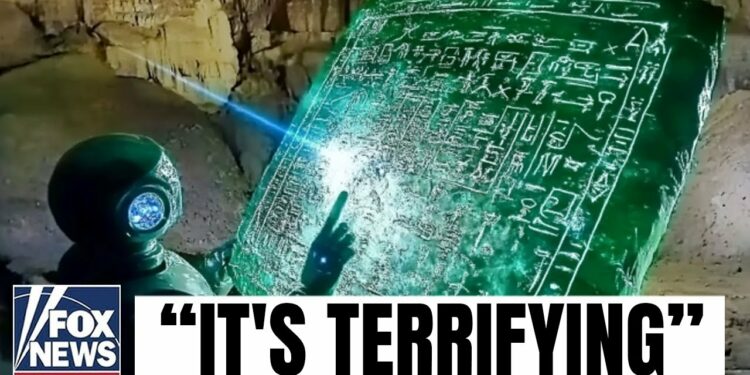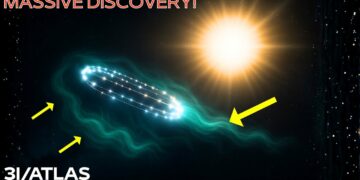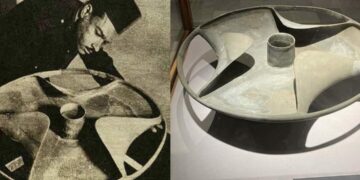Ancient relics are being illuminated by artificial intelligence, uncovering secrets from dusty manuscripts, faded carvings, and forgotten scripts. AI is decoding hidden messages, but are we recovering lost knowledge or awakening something ominous?
Siberian Unicorn
The Siberian unicorn (Elasmotherium sibiricum), a real Ice Age creature, was a massive rhinoceros with a prominent forehead horn, roaming Eurasian grasslands. Once thought extinct 100,000 years ago, a 29,000-year-old skull found in Kazakhstan shows it coexisted with humans. Its size and horn likely inspired unicorn myths. Dental studies indicate a grazing diet, and radiocarbon dating refines its extinction timeline, connecting real creatures to humanity’s enduring legends.
Giza Pyramids
The Giza pyramids, rising from Egypt’s desert, awe visitors millennia after their construction. The Great Pyramid of Khufu, the tallest man-made structure for nearly 4,000 years, showcases precise engineering with massive stone blocks. Chambers like the King’s and Queen’s rooms, along with intricate corridors, spark curiosity. Modern scans reveal potential undiscovered voids, highlighting ancient Egypt’s unmatched organizational prowess.
Tutankhamun’s Meteorite Dagger
Among Tutankhamun’s treasures is a dagger forged from meteoritic iron, a rare material in the 14th century BC. Its high nickel content confirms its extraterrestrial origin, and its exquisite gold hilt reflects divine significance in ancient Egypt. Non-invasive tests like X-ray fluorescence reveal a culture linking cosmic phenomena to religious beliefs, tying the boy king to the heavens.
Oxus Treasure
Discovered in the 19th century near the Oxus River, this hoard of 180 gold and silver objects—bracelets, coins, plaques, and chariots—blends Persian, Greek, and local artistry. Portable X-ray fluorescence confirms its ancient origins, offering a glimpse into Central Asian civilizations’ wealth, spirituality, and role in global trade.
Indus Valley Script
The undeciphered script of the Indus Valley civilization, from over 4,000 years ago in modern Pakistan and northwest India, adorns seals, pottery, and tablets. Its short inscriptions may represent words or ideas, possibly for trade, rituals, or governance. Computational analysis reveals structured syntax, but without a Rosetta Stone, full translation remains elusive.
Dead Sea Scrolls
Found in 1947 by a Bedouin shepherd, the Dead Sea Scrolls (3rd century BC to 1st century AD) include biblical texts, apocrypha, and community rules, preserved in clay jars. Multispectral imaging recovers faded text, revealing the diverse religious landscape of the Second Temple period, shaping Judaism and Christianity.
Nazca Lines
The Nazca Lines, colossal geoglyphs in southern Peru (500 BC–500 AD), depict animals, plants, and shapes visible from the sky. Likely tied to religious or ceremonial purposes, possibly to summon rain, they are studied with drones and high-resolution imaging, uncovering hidden figures and reinforcing their ritual significance.
Sutton Hoo Ship Burial
Unearthed in 1939 in Suffolk, England, the Sutton Hoo ship burial, possibly of King Raedwald, reveals a rotted ship’s imprint surrounded by weapons, jewelry, and the iconic Sutton Hoo helmet. This find highlights an Anglo-Saxon society rich in artistry, trade, and cultural complexity, far from a “Dark Age.”
Inca Ice Mummies
In the Andes, Inca child mummies, like the Ice Maiden, were preserved by cold during capacocha sacrifices. Non-invasive imaging reveals details like diets and ornate garments, showing the ritual’s role in maintaining cosmic harmony, a haunting glimpse into Inca spirituality.
Pompeii Graffiti
Pompeii’s graffiti, preserved by volcanic ash, captures daily life with love notes, political slogans, and tavern praises. Advanced imaging recovers faint inscriptions, revealing a lively, opinionated community that mirrors modern human expression.
Dwarka
The legendary city of Dwarka, tied to Lord Krishna in Hindu texts, may have a basis in reality. Underwater ruins off India’s Gujarat coast, including walls and artifacts, suggest an ancient coastal civilization. Sonar and submersible cameras continue to explore, linking myth to history.
Herculaneum Scrolls
Carbonized by Vesuvius in 79 AD, Herculaneum’s papyrus scrolls hold potential insights into Roman philosophy. X-ray scanning and data processing virtually unroll them, revealing texts on ethics and pleasure, possibly linked to Epicurian philosopher Philodemus, offering voices from a lost world.
Viking Longships
Viking longships, with shallow hulls and overlapping planks, enabled exploration across seas and rivers. Archaeological finds, like ship graves, reveal tools and weapons, showcasing Viking engineering and their reach from Russia to Greenland, guided by sun, stars, and possibly sunstones.
Ötzi the Iceman
Found in 1991 in the Ötztal Alps, Ötzi, a 5,000-year-old mummy, wore a woven cloak and carried a copper axe. Evidence of an arrow wound suggests a violent death. His tattoos and stomach contents reveal early healing practices and diets, connecting us to prehistoric life.
Austrian Roman Gladiator School
Near Carnuntum, a Roman gladiator school (ludus) reveals training yards and artifacts like armor and tools. This site shows how Rome’s passion for gladiatorial combat reached its frontiers, fostering a vibrant arena culture.
Pompeii’s Street Food
Pompeii’s thermopolia, ancient eateries, served stews, fish, and wine to residents without kitchens. Vivid paintings and food residues, analyzed with ground scans, depict a bustling food culture, blending art and daily life.
Nebra Sky Disc
This 3,600-year-old bronze disc from Germany, adorned with gold sun, moon, and star inlays, may depict the Pleiades and solar cycles. Likely used for planting or religious rituals, it shows Bronze Age astronomical sophistication.
Mayan Glyphs
Mayan glyphs, blending phonetic and logographic symbols, record kings, wars, and myths on stelae and codices. Deciphered in the 20th century, they reveal a complex civilization documenting politics and cosmic cycles, aided by modern digital databases.























